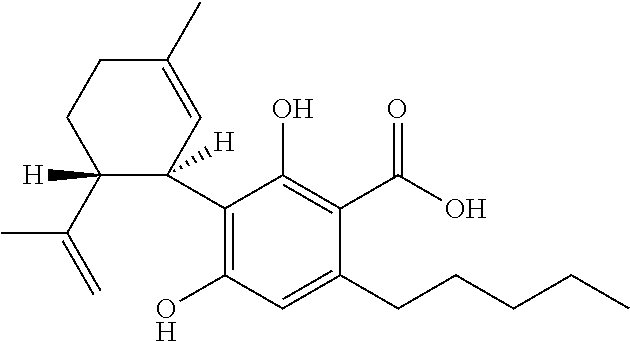Use of cannabinoids in the treatment of epilepsy
a cannabinoid and epilepsy technology, applied in the direction of biocide, plant/algae/fungi/lichens, drug compositions, etc., can solve the problems of difficult treatment, cognitive, behavioral and motor delays, and inability to obtain seizure freedom, so as to reduce the frequency of total convulsive seizures
- Summary
- Abstract
- Description
- Claims
- Application Information
AI Technical Summary
Benefits of technology
Problems solved by technology
Method used
Image
Examples
example 1
Efficacy of Cannabidiol in Children and Young Adults with Treatment-Resistant Epilepsy
Materials and Methods
[0069]Twenty-seven children and young adults with severe, childhood onset treatment-resistant epilepsy (TRE) were tested with a highly purified extract of cannabidiol (CBD) obtained from a cannabis plant. The participants in the study were part of an expanded access compassionate use program for CBD.
[0070]All patients entered a baseline period of 4 weeks when parents / caregivers kept prospective seizure diaries, noting all countable motor seizure types.
[0071]The patients then received a highly purified CBD extract (greater than 98% CBD w / w) in sesame oil, of known and constant composition, at a dose of 5 mg / kg / day in addition to their baseline anti-epileptic drug (AED) regimen.
[0072]The daily dose was gradually increased by 2 to 5 mg / kg increments until intolerance occurred or a maximum dose of 25 mg / kg / day was achieved.
[0073]Patients were seen at regular intervals of 2-4 weeks....
example 2
Efficacy of Cannabidiol in Children and Young Adults with Treatment Resistant Dravet Syndrome
Materials and Methods
[0087]Nine children and young adults with treatment-resistant Dravet syndrome were part of an expanded access compassionate use program for highly purified CBD extract as described in Example 1.
Results
[0088]All nine patients with Dravet syndrome were taking at least two concomitant anti-epileptic drugs. These were largely AED operating via GABA and included clobazam; levetiracetam; topiramate; stiripentol; phenobarbital; lacsamide; valproic acid; and zonisamide. The average number of concomitant antiepileptic drugs being taken was 2.7.
[0089]The mean number of seizures that these patients suffered from before starting treatment was 35 seizures per month, with a range of 6 to 112 seizures per month recorded.
[0090]Efficacy results for the 9 patients are summarized in Table 3 below.
TABLE 3Changes in Seizure Frequency with CBDTherapy in Dravet Syndrome patientsAll patientsexc...
example 3
Efficacy of Cannabidiol in Children and Young Adults with Treatment Resistant Myoclonic Absence Seizures
Materials and Methods
[0095]Four children and young adults with treatment-resistant myoclonic absence seizures were part of an expanded access compassionate use program for highly purified CBD extract as described in Example 1.
Results
[0096]All four patients with myoclonic absence seizures were taking at least two concomitant anti-epileptic drugs. These were largely AED operating via GABA and included clobazam; levetiracetam; topiramate; stiripentol; phenobarbital; lacsamide; valproic acid; and zonisamide. The average number of concomitant antiepileptic drugs being taken was 2.7.
[0097]Efficacy results for the four patients are summarized in Table 4 below.
TABLE 4Changes in Seizure Frequency with CBD Therapy inpatients with myoclonic absence seizures (MAS)All patientsexcluding MASMAS patientsAll patientspatients(n = 4)(n = 27)(n = 23)Responder rate (>50%2 [50%]13 [48%]11 [48%]reductio...
PUM
 Login to View More
Login to View More Abstract
Description
Claims
Application Information
 Login to View More
Login to View More - R&D
- Intellectual Property
- Life Sciences
- Materials
- Tech Scout
- Unparalleled Data Quality
- Higher Quality Content
- 60% Fewer Hallucinations
Browse by: Latest US Patents, China's latest patents, Technical Efficacy Thesaurus, Application Domain, Technology Topic, Popular Technical Reports.
© 2025 PatSnap. All rights reserved.Legal|Privacy policy|Modern Slavery Act Transparency Statement|Sitemap|About US| Contact US: help@patsnap.com



